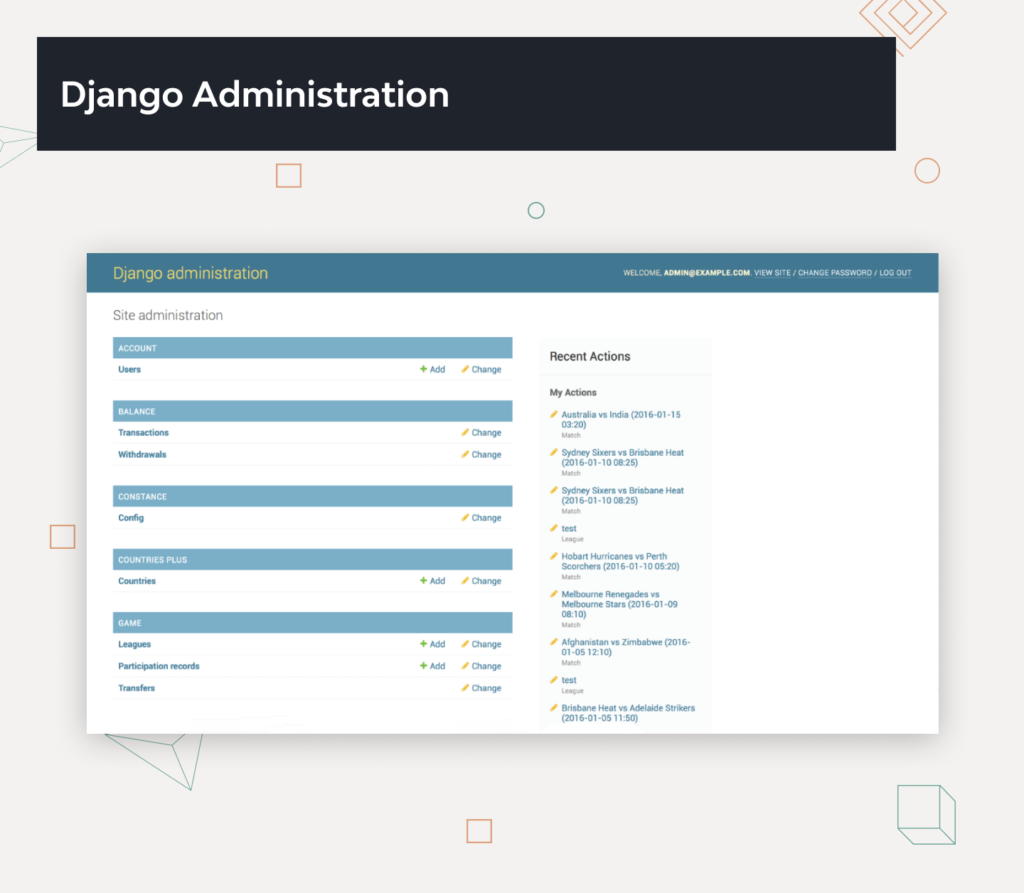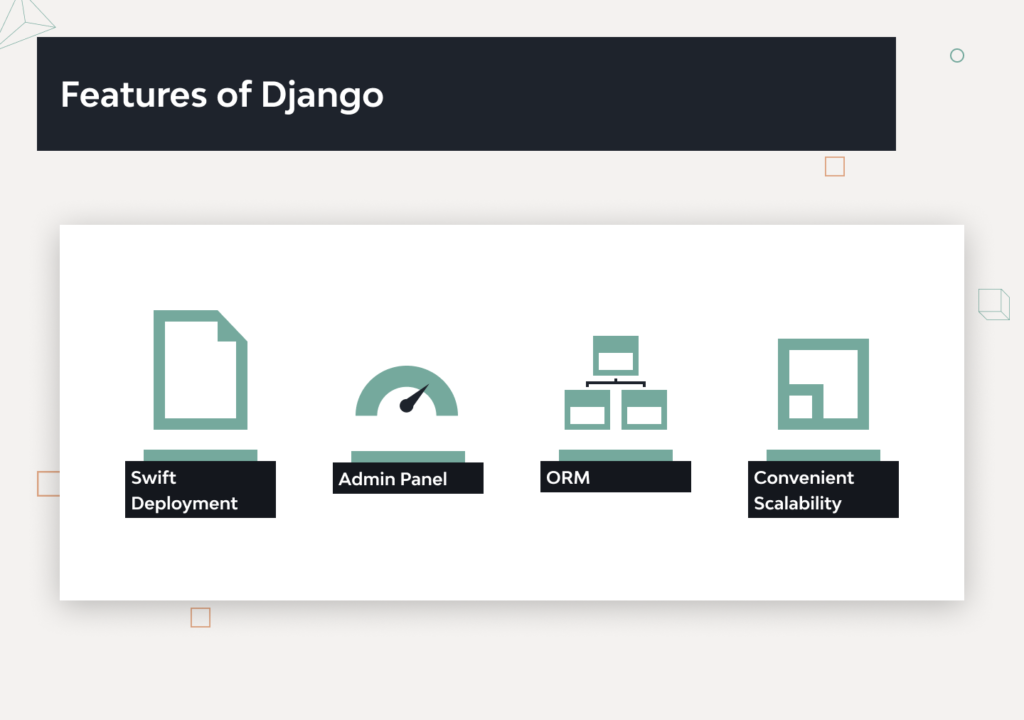
Choosing a web development framework is a big deal. There are quite a few frameworks on the market, each designed to address different project needs. For many companies and independent projects, the Django framework is an easy choice — it’s one of the most popular web development tools. But why is that? What is Django used for? What kind of projects? Let’s figure out what Django is and why so many developers around the world use it – and how you can do the same.
So, What Is the Django Framework?
Django is an open-source framework for backend web applications based on Python — one of the top web development languages. Its main goals are simplicity, flexibility, reliability, and scalability. And when introduced to what is Django, Python and its features open up in a new way.
Django has its own naming system for all functions and components (e.g., HTTP responses are called “views”). It also has an admin panel, which is deemed easier to work with than in Lavarel or Yii, and other technical Django features, including:
- Simple syntax;
- Its own web server;
- MVC (Model-View-Controller) core architecture;
- “Batteries included” (comes with all the essentials needed to solve solving common cases);
- An ORM (Object Relational Mapper);
- HTTP libraries;
- Middleware support; and
- A Python unit test framework.

Why We Use the Django Framework
Of course, the development toolkit is not limited to a combination of Python-Django: frameworks like Flask, Pyramid, FastAPI, or Tornado can provide a Python developer with different possibilities. In each particular case, this will mean different answers to why Django is better than Flask, or vice versa. But Django is one of the top-3 Python web frameworks due to its strengths.It’s fast and simple
One of Django’s main goals is to simplify work for developers. To do that, the Django framework uses:- The principles of rapid development, which means developers can do more than one iteration at a time without starting the whole schedule from scratch;
- DRY philosophy — Don’t Repeat Yourself — which means developers can reuse existing code and focus on the unique one.

It’s secure
Security is also a high priority for Django. It has one of the best out-of-the-box security systems out there, and it helps developers avoid common security issues, including- clickjacking,
- cross-site scripting, and
- SQL injection.
It suits any web application project
With Django, you can tackle projects of any size and capacity, whether it’s a simple website or a high-load web application. Why use Django for your project? Because:- It’s fully loaded with extras and scalable, so you can make applications that handle heavy traffic and large volumes of information;
- It is cross-platform, meaning that your project can be based on Mac, Linux or PC;
- It works with most major databases and allows using a database that is more suitable in a particular project, or even multiple databases at the same time.
It’s well-established
Django is very good for web development. It is time- and crowd-tested. It has a big, supportive community accessed through numerous forums, channels, and dedicated websites. It’s easy to find help when there’s a problematic function in the code, and to find developers if your company is looking to base the next project on Django.Django started off with great documentation, the best of any other open-source framework. And it’s still maintained on a high level, updated along with the new functions and fixes, so you can easily adapt to changes.It will not be difficult for a developer to figure out how to use Django in a particular case. You can trust that any issues with the framework will be solved as soon as they arise. The software is constantly updated and new packages are released to make working with Django more convenient than it already is.
What You Can Do with Django
Here’s an interesting fact: Django was first created to power a web application for a newspaper publisher, the Lawrence Journal-World. You can expect it to be amazing at handling projects with volumes of text content, media files, and heavy traffic — or anything else that works like a web-based periodical.But the publishing industry is not the framework’s only area of application. Django is also used to build eCommerce websites and health care and financial applications for transportation and booking, social media sites, and more. Here are some of the many project types you can develop using the framework:- Financial platforms with features for analyzing and calculating approximate results based on personal data, risk tolerance, the probability of achieving goals;
- Built-in custom CRM systems for internal data;
- B2B CRM systems for handling communication between businesses;
- Platforms that facilitate communication between two parties, such as a business and a consumer;
- High-load booking engines or shopping platforms;
- Android and iOS mobile apps that support web applications;
- Real estate property evaluation systems;
- Document management systems;
- Platforms for handling legal issues like verifying mortgage conditions or lease status.
- An emailing system for sending notifications to users;
- A filtering system with advanced logic and dynamically changing rules;
- Algorithm-based generators;
- Data-analysis tools;
- Interfaces for managing investment funds;
- Admin dashboards;
- Photo-based verification systems;
- And other features that facilitate the development of CRM and B2B platforms, online marketplaces, booking systems, and more.

Famous Companies That Use the Django Framework
Django is the choice of many, and it’s also the choice of the Internet’s giants. Here are some of the popular web applications enjoy Django’s speed, flexibility, and ease of use:- Instagram: Another popular social network that deals with a great deal of media data and user interactions. Django enables the functionality that makes the web application work seamlessly, add new features, and fix issues in no time.
- Spotify: A large media library with huge volume of information that allows users to listen to music free of charge or on an ad-free subscription basis. On the technical side of things, Spotify also uses machine learning, where Python is one of the best choices. The creators chose to combine it with the Django framework.
- The Washington Post: It’s no wonder that The Washington Post would use Django to handle its heavy traffic, since the framework itself was created to power an online newspaper. Several other online periodicals also use Django.
- Dropbox: A cloud technology for file storage requires high-performance functionality. Django provides Dropbox with the tools it needs to provide sharing and synchronization, as well as scalability.
- Mozilla: One of the most popular web browsers, and another web application that switched from PHP to Python, and thus to Django. Now, it is better able to handle huge traffic and API hits.
- NASA: They use Django for some of the functional elements that require the most reliability. Their website is not as popular as Instagram, for example, yet it handles high-resolution imagery and an average of 2 million views per month.
- Pinterest: This platform has well over 250 million active users per month, handles huge volumes of media data, and yet manages to sustain its user-friendly interface. Thanks to its open-source framework, the creators were able to modify it to suit their needs.
- Reddit: What’s the first site go to for social news and discussions? For many people, it’s Reddit — a web content platform where people ask questions, share opinions, and where posts are promoted based on a rating system. Reddit relies on Django for many of its functional capabilities, like servicing heavy user traffic.

